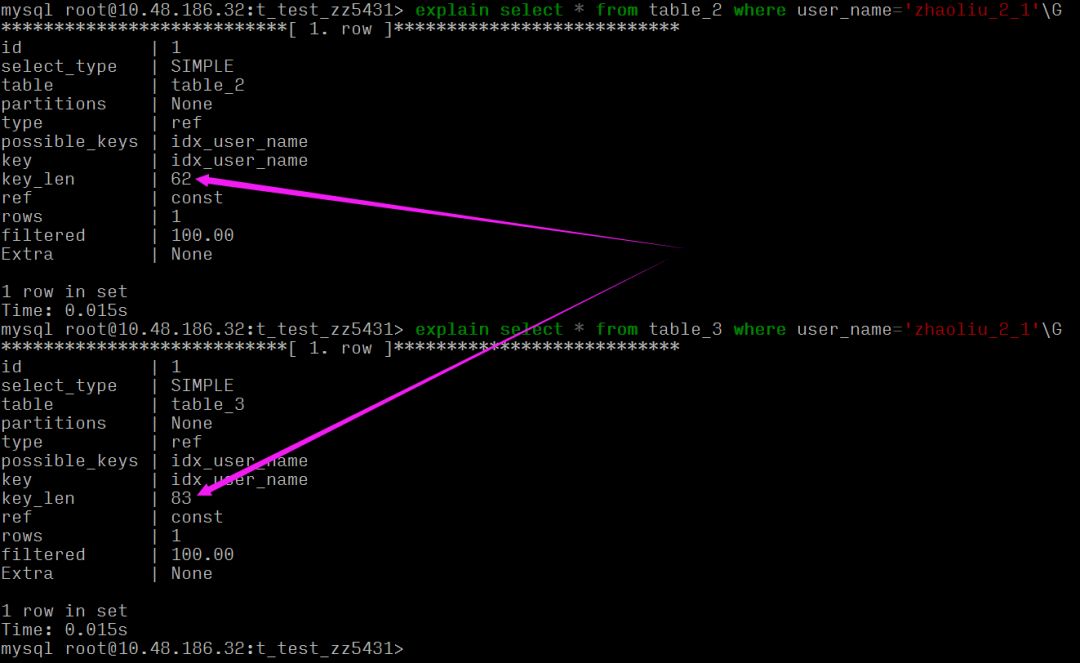SQL
MySQL 官网文档:
NULL columns require additional space in the rowto record whether their values are NULL. For MyISAM tables, each NULL columntakes one bit extra, rounded up to the nearest byte.
MySQL难以优化引用可空列查询,它会使索引、索引统计和值更加复杂。可空列需要更多的存储空间,还需要MySQL内部进行特殊处理。可空列被索引后,每条记录都需要一个额外的字节,还能导致MYisam 中固定大小的索引变成可变大小的索引。
—— 出自《高性能MySQL第二版》
不用 Null 的理由
- 所有使用
NULL值的情况,都可以通过一个有意义的值的表示,这样有利于代码的可读性和可维护性,并能从约束上增强业务数据的规范性。 NULL值到非NULL的更新无法做到原地更新,更容易发生索引分裂,从而影响性能。 :::tips 注意:但把NULL列改为NOT NULL带来的性能提示很小,除非确定它带来了问题,否则不要把它当成优先的优化措施,最重要的是使用的列的类型的适当性。 :::NULL值在timestamp类型下容易出问题,特别是没有启用参数explicit_defaults_for_timestampNOT IN、!=等负向条件查询在有NULL值的情况下返回永远为空结果,查询容易出错
举例:
create table table_2 (`id` INT (11) NOT NULL,user_name varchar(20) NOT NULL)create table table_3 (`id` INT (11) NOT NULL,user_name varchar(20))insert into table_2 values (4,"zhaoliu_2_1"),(2,"lisi_2_1"),(3,"wangmazi_2_1"),(1,"zhangsan_2"),(2,"lisi_2_2"),(4,"zhaoliu_2_2"),(3,"wangmazi_2_2")insert into table_3 values (1,"zhaoliu_2_1"),(2, null)-- 1、NOT IN子查询在有NULL值的情况下返回永远为空结果,查询容易出错select user_name from table_2 where user_name not in (select user_name from table_3 where id!=1)mysql root@10.48.186.32:t_test_zz5431> select user_name from table_2 where user_name not-> in (select user_name from table_3 where id!=1);+-------------+| user_name ||-------------|+-------------+0 rows in setTime: 0.008smysql root@10.48.186.32:t_test_zz5431>-- 2、单列索引不存null值,复合索引不存全为null的值,如果列允许为null,可能会得到“不符合预期”的结果集-- 如果name允许为null,索引不存储null值,结果集中不会包含这些记录。所以,请使用not null约束以及默认值。select * from table_3 where name != 'zhaoliu_2_1'-- 3、如果在两个字段进行拼接:比如题号+分数,首先要各字段进行非null判断,否则只要任意一个字段为空都会造成拼接的结果为null。select CONCAT("1",null) from dual; -- 执行结果为null。-- 4、如果有 Null column 存在的情况下,count(Null column)需要格外注意,null 值不会参与统计。mysql root@10.48.186.32:t_test_zz5431> select * from table_3;+------+-------------+| id | user_name ||------+-------------|| 1 | zhaoliu_2_1 || 2 | <null> || 21 | zhaoliu_2_1 || 22 | <null> |+------+-------------+4 rows in setTime: 0.007smysql root@10.48.186.32:t_test_zz5431> select count(user_name) from table_3;+--------------------+| count(user_name) ||--------------------|| 2 |+--------------------+1 row in setTime: 0.007s-- 5、注意 Null 字段的判断方式, = null 将会得到错误的结果。mysql root@localhost:cygwin> create index IDX_test on table_3 (user_name);Query OK, 0 rows affectedTime: 0.040smysql root@localhost:cygwin> select * from table_3 where user_name is null\G***************************[ 1. row ]***************************id | 2user_name | None1 row in setTime: 0.002smysql root@localhost:cygwin> select * from table_3 where user_name = null\G0 rows in setTime: 0.002smysql root@localhost:cygwin> desc select * from table_3 where user_name = 'zhaoliu_2_1'\G***************************[ 1. row ]***************************id | 1select_type | SIMPLEtable | table_3type | refpossible_keys | IDX_testkey | IDX_testkey_len | 23ref | constrows | 1Extra | Using where1 row in setTime: 0.006smysql root@localhost:cygwin> desc select * from table_3 where user_name = null\G***************************[ 1. row ]***************************id | 1select_type | SIMPLEtable | Nonetype | Nonepossible_keys | Nonekey | Nonekey_len | Noneref | Nonerows | NoneExtra | Impossible WHERE noticed after reading const tables1 row in setTime: 0.002smysql root@localhost:cygwin> desc select * from table_3 where user_name is null\G***************************[ 1. row ]***************************id | 1select_type | SIMPLEtable | table_3type | refpossible_keys | IDX_testkey | IDX_testkey_len | 23ref | constrows | 1Extra | Using where1 row in setTime: 0.002smysql root@localhost:cygwin>
Null 列需要更多的存储空间:需要一个额外字节作为判断是否为 NULL 的标志位
举例:
alter table table_3 add index idx_user_name (user_name);alter table table_2 add index idx_user_name (user_name);explain select * from table_2 where user_name='zhaoliu_2_1';explain select * from table_3 where user_name='zhaoliu_2_1';

可以看到同样的 varchar(20) 长度,table_2 要比 table_3 索引长度大,这是因为:
两张表的字符集不一样,且字段一个为 NULL 一个非 NULL。
key_len 的计算规则和三个因素有关:数据类型、字符编码、是否为 NULL
- key_len 62 == 20*3(utf8 3字节) + 2 (存储 varchar 变长字符长度 2字节,定长字段无需额外的字节)
- key_len 83 == 20*4(utf8mb4 4字节) + 1 (是否为 Null 的标识) + 2 (存储 varchar 变长字符长度 2字节,定长字段无需额外的字节)
所以说索引字段最好不要为NULL,因为NULL会使索引、索引统计和值更加复杂,并且需要额外一个字节的存储空间。

